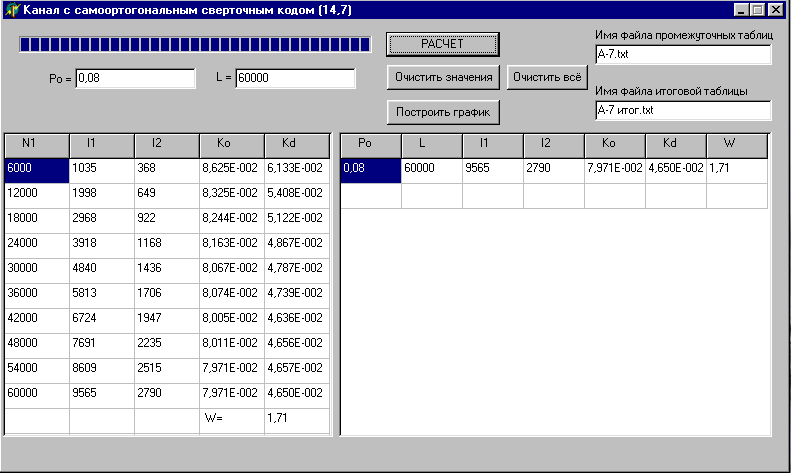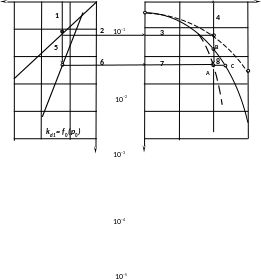
- •3 Laboratory works Laboratory work 1 Cyclic code codecs construction principles research
- •Laboratory work 2 Cyclic codes correcting capability research
- •Laboratory work 3 Error correction principle of convolutional code with the threshold decoding algorithm
- •Laboratory work 4 Systematic convolutional codes correcting capability research
- •Laboratory work 5 Nonsystematic convolutional codes correcting capability research
- •Laboratory work 6 Digital communication system with a concatenated coding research
- •Laboratory work 7 Turbo-codes with iterative soft-decision Viterbi decoding algorithm corrective capability research
Laboratory work 4 Systematic convolutional codes correcting capability research
Objective: To determinate the quality parameters of the system with the error-correction coding by convolutional code (14, 7) with a threshold algorithm decoding in a channel with additive white Gaussian noise (AWGN).
Laboratory emulator:
After opening the file “Project1.exe” you can see interface like fig. 3.6.

Figure 3.6 – The interface of laboratory work
You need enter the data from table 3.6, where p0 – error probability, L – amount of codewords.
Table 3.6 – Results of coding gain by error probability in the DSC
p0 |
0,07 |
0,05 |
0,03 |
0,01 |
0,005 |
0,003 |
L |
25·104 |
5·105 |
75·104 |
106 |
4·106 |
5·106 |
Wep |
|
|
|
|
|
|
In the result of the experiment, you get next parameters:
i1 – amount of errors in the discrete symmetric channel (DSC);
i2 – amount of uncorrected errors by the decoder;
k0 – errors coefficient in the DSC, k0 nearly equal p0;
kd – errors coefficient in the output of the decoder;
W – coding gain.
These parameters are calculated by formulas:
k0 =i1/2L, kd =i2/L, W= k0/kd.
Then you can get the diagram kd1 = f0(p0) after putting the button “Построить график”, as shown in fig. 3.7a.
For
building of the diagram for determination of coding gain W
in the channel with AWGN it is need to use two subsidiary diagrams in
the fig 3.7b.
The first diagram is the characteristic of the channel with PM-2
without coding
![]() .
The second diagram
.
The second diagram
![]() with the double energy of the bit (as the relative information
transfer rate R
=
½).
with the double energy of the bit (as the relative information
transfer rate R
=
½).
p0 10–3 10–2 Р01 10-1 100 0 1 2 h1 3 h

p0
=
f2(![]() h)
h)
kd =p0
kd2=
f3
(
h)
p0
=f1(![]() h)
h)
kd kd, p0
а) b)
Figure 3.7 – The characteristic of the DSC and the channel with AWGN
For example, for given value p01 we can determinate the signal/noise ratio h1 using the path 1→2→3→4. The value h1 corresponds to error probability p01 in the output of the PM-2 demodulator. Take to account that there is convolutional decoder (14, 7) before PM-2 demodulator, which decreases error probability p0 in W times. That’s why the place of the point A on the diagram kd2 = f3( h) is determined using the paths 1→5→6→7 and 4→8. For getting the characteristic kd2 it is need to use some values of p0.
Laboratory task:
To open the file “Project1.exe”.
To enter initial data from the table 3.6 and fill it.
To draw the characteristic kd1 = f0 (p0).
To build the graph kd2 = f3( h) using the values p0 from the table 3.6.
To determine the value hlim when the convolutional code (14, 7) is reasonable.
Home task:
To learn items 1.3.1 – 1.3.2 of this teaching manual.
To write down the answers to the general questions.
To prepare the table 3.6 in the protocol.
To prepare blank using Application B.
General questions:
What does the characteristic kd1 = f0 (p0) describe?
What does the characteristic kd2 = f3( h) describe?
Determinate the coding gain by error probability Wep = p3/p4, where p3 – error probability in the channel without coding, p4 – with coding, if h = 2,1 and 2,3 using the diagram 3.7b.
Protocol content:
Subject and objective.
Executed home task.
Graph and table according to laboratory task.
Conclusion. Compare two characteristics of kd1 = f0(p0) and kd = f(p0) from the laboratory work 2.
